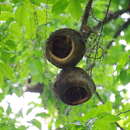fi
nimet breadcrumb-navigoinnissa


Lecythis ollaria is a species of tree found growing in forests in Brazil, Guyana, and Venezuela. The tree is known locally as coco de mono, and accumulates selenium in its tissues.
The paradise nut is a large tree with spreading branches. It is in the same family as the Brazil nut tree (Bertholletia excelsa) and has a similar fruit. This is a large woody capsule with a lid which bursts open when the seeds are ripe. Monkeys are said to put their hands inside the capsule in order to extract the seeds which have a fleshy interior rich in oil and a woody outer casing.[2]
The nuts have a pleasant flavour and are eaten by humans.[2] When two previously healthy women in South America developed unexplained nausea, vomiting and neurological symptoms, followed two weeks later by heavy hair loss, no cause could at first be found. It was later established that they were suffering from acute selenium toxicity brought on by eating paradise nuts. They still had elevated levels of selenium in their blood eight weeks after they had eaten the nuts.[3] Further investigation of the tree found that the tissues of the bark, leaves, capsules and seeds all contained selenium but that the highest concentration was in the nuts which contained about five grams per kilogram, about half of which was soluble in water.[4] The tree is considered to be a selenium accumulator and part of the element is bound to very selenium-rich proteins.[5]
The IUCN Red List of Threatened Species lists the paradise nut as being of least concern. This is because it has a widespread geographical distribution in the tropical rainforest.[1]
Lecythis ollaria is a species of tree found growing in forests in Brazil, Guyana, and Venezuela. The tree is known locally as coco de mono, and accumulates selenium in its tissues.
La olla de mono u ollato[1] (Lecythis ollaria) en un árbol de la familia Lecythidaceae, que se encuentra en las selvas de Brasil y Venezuela. Acumula selenio en sus tejidos. Algunos autores caracterizan su fruto como "calabaza" por su corteza dura.[2]
Lecythis ollaria fue descrito por Pehr Löfling y publicado en Iter Hispanicum 189. 1758.[3]
La olla de mono u ollato (Lecythis ollaria) en un árbol de la familia Lecythidaceae, que se encuentra en las selvas de Brasil y Venezuela. Acumula selenio en sus tejidos. Algunos autores caracterizan su fruto como "calabaza" por su corteza dura.
Lecythis ollaria est une espèce d'arbres dicotylédones de la famille des Lécitidacées originaires du Vénézuela.
La description de l'espèce a été publiée en 1758 par le botaniste suédois Pehr Loefling[2]. L'épithète spécifique « ollaria » fait référence à son fruit en forme de pot[3].
Le genre Lecythis est assigné à la famille des Lecythidaceae, dans l'ordre des Ericales.
Le fruit est localement nommé wabi[réf. nécessaire].
Le bois est parfois commercialisé, parmi d'autres espèces, sous le nom de manbarklak[réf. nécessaire], de même que les arbres du genre Eschweilera, très proches. L'un des synonymes de Lecythis ollaria est d'ailleurs Eschweilera cordata (O.Berg) Miers [4].
Lecythis ollaria est une espèce d'arbres dicotylédones de la famille des Lécitidacées originaires du Vénézuela.
Lecythis ollaria là một loài thực vật linhin thuộc họ Lecythidaceae. Loài này có ở Brasil và Venezuela.
Phương tiện liên quan tới Lecythis ollaria tại Wikimedia Commons
Lecythis ollaria là một loài thực vật linhin thuộc họ Lecythidaceae. Loài này có ở Brasil và Venezuela.